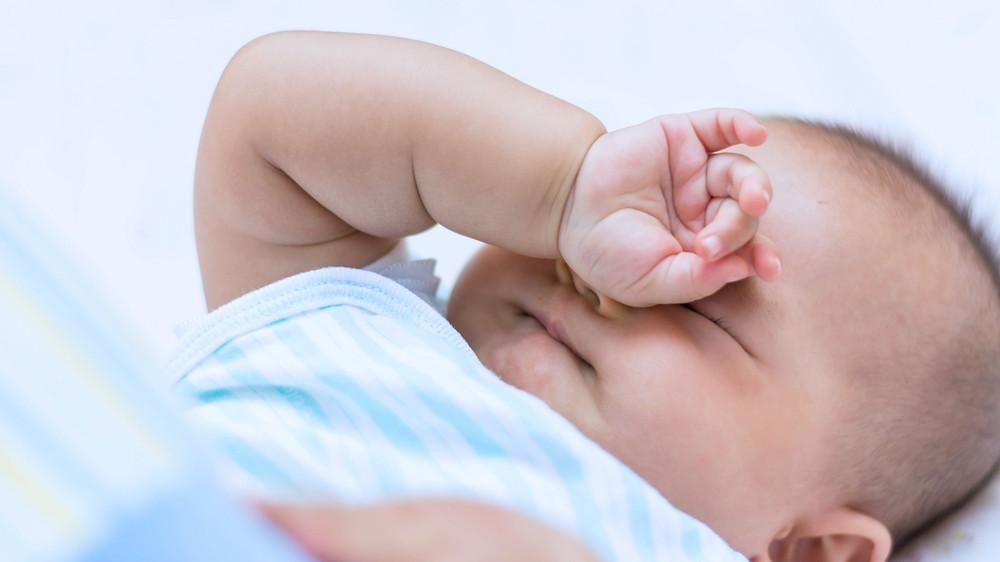BABY
How to Get an Overtired Baby to Sleep
Signs your baby is ready for sleep.

Written by
Dr. Harvey Karp

SHARE THIS ARTICLE
PARENT PICKS
Bestsellers
BABY

Written by
Dr. Harvey Karp

SHARE THIS ARTICLE
Bestsellers
Most people think a baby is ready for slumber when their eyes get lidded and their head slumps against our shoulder. Actually, at that point they are overtired.
Many tired babies can sleep anywhere, anytime. But those with a challenging temperament or poor state control live on a tightrope. Growing weariness can suddenly tip them off balance and send them crashing down from a happy alertness to exhausted misery in a blink.
So, if your well-meaning neighbor says to keep your tired baby awake during the day to boost their sleep at night, don’t do it! This strategy may work for adults, but it usually backfires with babies, leading to bigger struggles falling into sleep…and staying there.
In his classic book Healthy Sleep Habits, Happy Baby, sleep expert Dr. Mark Weissbluth states, “Sleep begets sleep.” He’s right…and that’s why experienced parents put their babies to sleep before they get overtired.
Some common early signs of an overtired baby include:
While these signs will tip you off that your sweet pea needs to hit the hay, the truth is, by the time they’re showing signs of sleepiness, they are overtired. A better bet is to get to know your little one’s routine so you can anticipate when they’ll be ready to nod off.
Wouldn’t it be nice if the hospital issued you a crystal ball the same time they sent you home with your little bundle of joy? While so many parts of parenting are—and will continue to be—woefully unpredictable, there are ways to foresee when your bub is ready for bed.
Knowing how much sleep babies usually need can give you a good sense of when you’re on the verge of keeping your lovebug awake too long. Here’s a guideline for how much sleep to expect in the baby years:
![[object Object]](/_next/image?url=https%3A%2F%2Fcdn.sanity.io%2Fimages%2F301lhh0a%2Fproduction%2Fc5ad7840634c66125afe5f8a6fd1004068602a7d-480x480.jpg&w=1080&q=75)
Along with figuring out the total sleep your little one needs, you’ll want to keep an eye on what are called “wake windows.” A wake window is the length of time your baby can comfortably stay awake between sleeps. So if your baby consistently shows signs of overtiredness 2 hours after waking, their wake window is probably just shy of 2 hours. As babies get older, their wake windows get longer. Here are common wake windows by age:
![[object Object]](/_next/image?url=https%3A%2F%2Fcdn.sanity.io%2Fimages%2F301lhh0a%2Fproduction%2Fda19ddfb174ad8df9c13446d3afc6a37de714f89-480x480.jpg&w=1080&q=75)
As time goes on, it will get easier and easier to recognise your little one’s sleepy-time cues. Putting your baby down before they show signs of being overtired and cranky will not only be easier for you, but it will also set them up to get the best sleep possible!
If you’re having trouble figuring out how to get an overtired baby to sleep, try the 5 S’s. Early in my career as a pediatrician, I became determined to get to the bottom of colicky crying.
For a long time, experts thought that colic stemmed from tummy trouble, but what I found was that it was actually the result of babies being born about three months…too early! Babies enjoy nine cozy months in the womb where they’re cradled by the uterus, serenaded by the whooshing sound of blood rushing through the womb’s walls, and are constantly jostled as Mum moves. So, when they’re born, and we try to place babies on a still, flat surface in a quiet room…it’s really jarring!
The 5 S’s (swaddling, holding a baby in the side or stomach position while soothing, shushing, swinging, and giving a pacifier to suck) help recreate the comforts of the womb. But more than that, these sensations trigger a baby’s calming reflex, which quiets crying and brings on sleep. (SNOO, my responsive bassinet, uses three of the 5S’s to respond to most fussing in under a minute and aid baby sleep!) The Happiest Baby on the Block streaming video breaks down these techniques and shares essential calming tricks to get your tired baby to sleep quicker and longer.
Disclaimer: The information on our site is NOT medical advice for any specific person or condition. It is only meant as general information. If you have any medical questions and concerns about your child or yourself, please contact your health provider. Breastmilk is the best source of nutrition for babies. It is important that, in preparation for and during breastfeeding, mothers eat a healthy, balanced diet. Combined breast- and bottle-feeding in the first weeks of life may reduce the supply of a mother's breastmilk and reversing the decision not to breastfeed is difficult. If you do decide to use infant formula, you should follow instructions carefully.